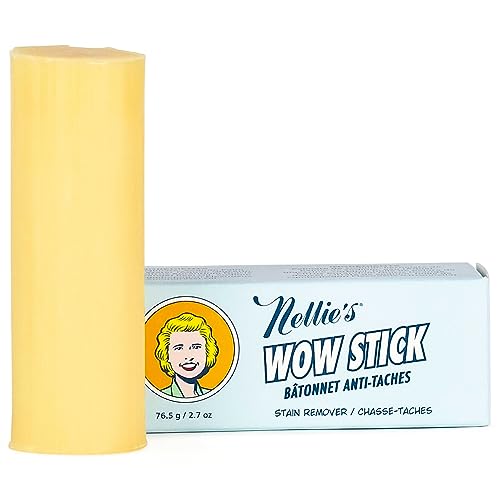
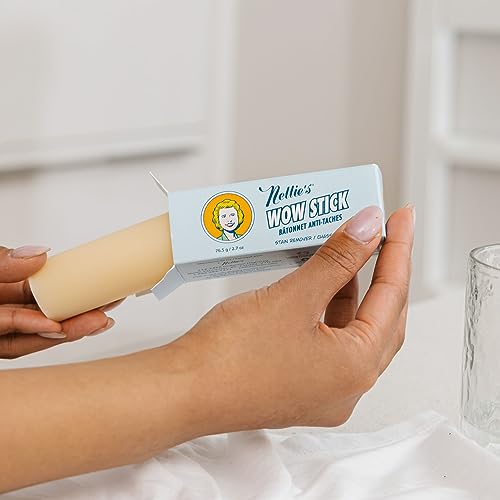
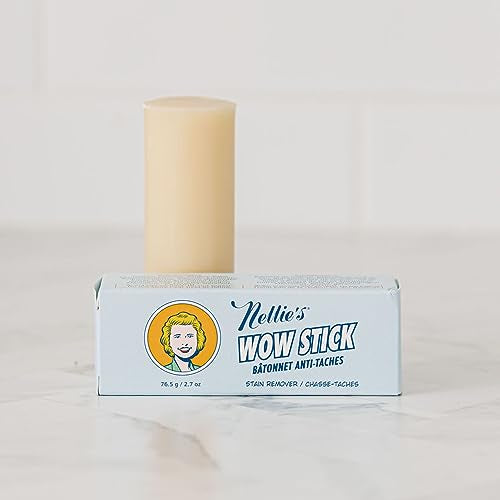
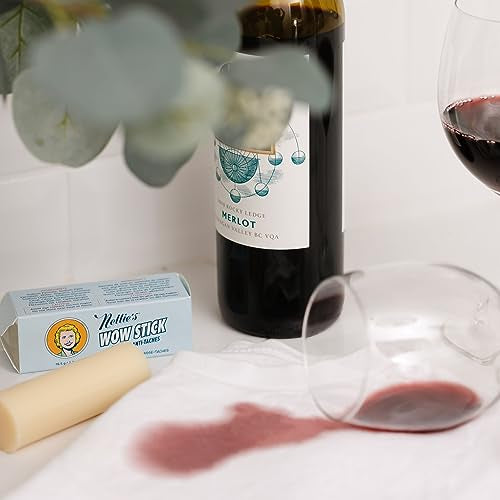
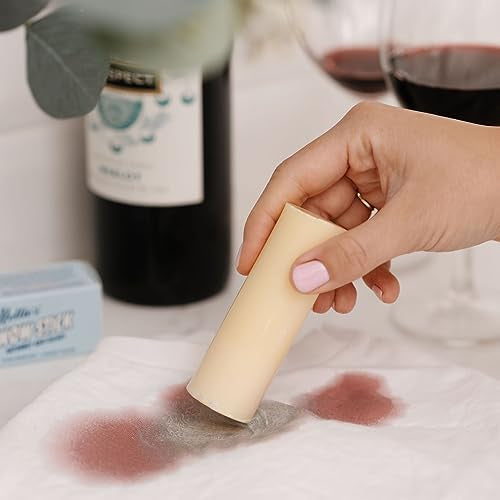
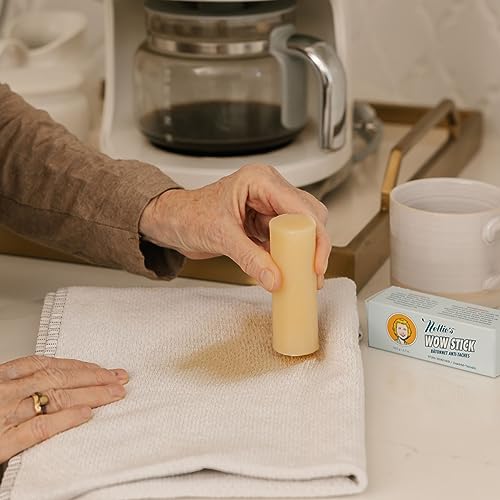
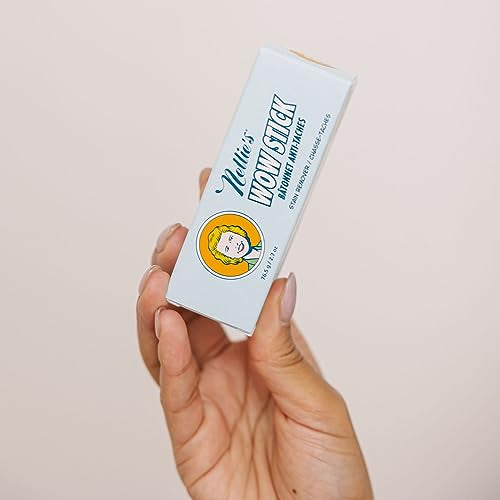
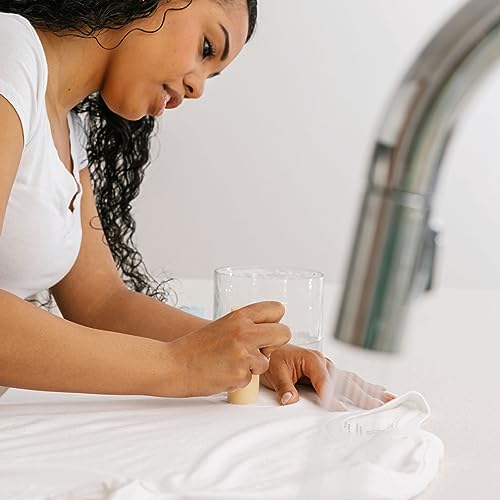
Nellie's Wow Stick Stain Remover - Powerful Plant-Based Formula for Tough Stains - 2.7oz


Geraniol
High RiskGeraniol is a naturally occurring scent ingredient commonly found in essential oils from plants such as geraniums and lemongrass. It is primarily used for its pleasant floral aroma in perfumes, cosmetics, and household products.
Sustai Insights
Geraniol serves as a fragrance component and offers a natural option for scenting products. However, it has a high allergenic potential and may cause skin irritation in sensitive individuals. While it is considered low risk for carcinogenicity and reproductive toxicity, regulatory bodies have placed restrictions on its use due to allergenic concerns. Overall, the assessment reflects a high-risk level, particularly for those prone to allergies, highlighting the need for caution in its application.
Cymbopogon Schoenanthus (Lemongrass)
High RiskCymbopogon schoenanthus, commonly known as lemongrass, is a tropical plant used primarily for its aromatic properties in culinary and cosmetic applications. It is often included for its potential antimicrobial and antioxidant effects, contributing to product preservation and fragrance.
Sustai Insights
Lemongrass offers functional benefits as a natural preservative and fragrance agent. However, it may pose risks due to its high allergenic potential and enhanced skin absorption, which could lead to irritation in sensitive individuals. Regulatory bodies have noted its restricted use in certain formulations. Overall, its risk level is assessed as high, particularly for those with allergies. Safe usage practices should be followed, and alternatives like citral-free essential oils could be considered.
Citrus Aurantium Dulcis (Orange) Peel Oil
Medium RiskCitrus aurantium dulcis (orange) peel oil is derived from the peel of oranges and is commonly used in cosmetic and personal care products for its fragrance and potential skin benefits. It is known for its aromatic properties and is often included in formulations aimed at enhancing scent profiles.
Sustai Insights
Citrus aurantium dulcis (orange) peel oil offers functional benefits such as providing a pleasant scent and potential antimicrobial properties. However, it poses a high allergy risk and may cause skin irritation in sensitive individuals. Environmental concerns include moderate persistence and potential to contribute to pollution. Regulatory warnings indicate restrictions on use in certain products. Overall, the risk level is assessed as medium, and users are advised to practice caution, particularly those with known allergies. Alternatives like sweet orange essential oil may provide similar benefits with potentially lower risks.
Geranial
Medium RiskGeranial is a naturally occurring compound found in essential oils, primarily derived from lemongrass. It is commonly used in fragrances and flavoring due to its lemon-like scent. Geranial acts as a fragrance component and is often included in personal care and cosmetic products.
Sustai Insights
Geranial offers functional benefits as a fragrance enhancer in various products. While it is generally well-tolerated, it has a moderate allergenic potential, and caution is advised for sensitive individuals. Environmentally, it does not appear to be bioaccumulative, but its use is restricted in some verified products. Overall, the risk level is assessed as medium, suggesting that while it is useful, careful consideration of exposure is warranted.
Limonene
Medium RiskLimonene is a scent ingredient and solvent naturally found in citrus fruits, commonly used in personal care and cleaning products for its fragrant properties. It serves as a flavoring agent and enhances the overall sensory experience of products.
Sustai Insights
Limonene offers functional benefits such as acting as a solvent and fragrance enhancer. However, it carries a high allergenic potential, which can trigger skin or respiratory sensitivities in some individuals. Environmental concerns include moderate persistence and bioaccumulation, along with potential ecotoxicity. Regulatory restrictions necessitate verification in products containing this ingredient. Overall, the risk level is assessed as medium, emphasizing the importance of cautious use, particularly for sensitive populations. Safer alternatives may be considered to mitigate these risks.
Water
Low RiskWater is a clear, colorless liquid essential for various biological processes. It serves as a solvent in formulations, facilitating the dissolution of other ingredients and enhancing product texture and application. Additionally, water plays a crucial role in hydration and is a key component in many cosmetic and personal care products.
Sustai Insights
Water is an effective solvent and hydrator, contributing to the texture and efficacy of formulations. It is biodegradable and generally regarded as safe, with low concerns regarding carcinogenicity, allergies, and reproductive toxicity. However, excessive water usage can lead to environmental concerns, particularly regarding resource depletion. Regulatory bodies do not impose restrictions on water use in cosmetics. Overall, the risks associated with water are low, making it a safe and essential ingredient.
Sodium Palmate
Low RiskSodium palmate is the sodium salt of fatty acids derived from palm oil, commonly used as a surfactant and emulsifier in cosmetic formulations. It helps to create lather and improve the texture of products, making it a popular ingredient in soaps and cleansers.
Sustai Insights
Sodium palmate offers functional benefits such as effective cleansing and emulsifying properties, contributing to product stability. It is considered low risk for health concerns, including carcinogenicity and allergenic potential, and has no significant environmental hazards. Regulatory bodies have not imposed restrictions on its use. Safe usage involves adhering to established concentrations, with no major alternatives highlighted. Overall, sodium palmate presents a low risk profile.
Cymbopogon Flexuosus Oil
Low RiskCymbopogon flexuosus oil is a volatile oil obtained from the leaves of the Cymbopogon flexuosus plant. It is commonly used for its aromatic properties and as a flavoring agent in various products.
Sustai Insights
Cymbopogon flexuosus oil offers functional benefits such as fragrance and flavoring, with a low environmental impact due to its biodegradable nature. Health risks are minimal, with low concerns for carcinogenicity, allergies, and reproductive toxicity. Regulatory bodies have not issued significant warnings, maintaining a low overall risk level. Safe usage practices should be followed to mitigate any potential skin absorption issues. No widely recognized alternatives are noted, reinforcing its position as a low-risk ingredient.
Sea Salt
Low RiskSea salt is a mixture of inorganic salts derived primarily from the evaporation of seawater. It consists mainly of sodium chloride, with minor amounts of other minerals. Sea salt is commonly used as a seasoning and preservative in food products and may also have applications in cosmetics and personal care items.
Sustai Insights
Sea salt serves as an effective flavor enhancer and preservative, contributing to the taste and shelf-life of food products. It is generally considered safe with low risk for health concerns such as cancer, allergies, and reproductive toxicity. Environmental impact is minimal, as it does not contribute significantly to pollution or bioaccumulation. Regulatory bodies, including the FDA, currently do not impose restrictions on its use. Overall, the risk level associated with sea salt is low, making it a widely accepted ingredient with no significant adverse effects reported.
Vegetarian Glycerin
Low RiskVegetarian glycerin, also known as glycerol, is a colorless, odorless, and viscous liquid derived from plant sources. It is primarily used as a humectant, solvent, and emollient in various personal care products, helping to retain moisture and improve texture.
Sustai Insights
Vegetarian glycerin offers functional benefits as an effective humectant, promoting hydration and skin smoothness. It is biodegradable and typically sustainably sourced. Health risks associated with glycerin are low, with no significant concerns for carcinogenicity, allergens, or reproductive toxicity. Environmental risks are minimal, and it is not subject to major regulatory warnings. Overall, the risk level for this ingredient is low, making it a safe choice in formulations. Safe usage practices include ensuring proper concentrations in products, and alternatives such as propylene glycol exist but may have differing properties.
Sodium Gluconate
Low RiskSodium gluconate is a sodium salt of gluconic acid, commonly used as a chelating agent in various personal care products. It functions primarily to bind metal ions, enhancing product stability and efficacy. Additionally, it may serve as a moisturizer and skin conditioning agent.
Sustai Insights
Sodium gluconate is valued for its functional benefits, including effective chelation and moisture retention, contributing positively to product performance. It is considered low risk concerning health impacts, with minimal concerns regarding carcinogenicity, allergies, or reproductive toxicity. Environmental assessments indicate low pollutant potential and minimal bioaccumulation. Regulatory bodies have not imposed significant restrictions. Safe usage practices are advised, particularly regarding enhanced skin absorption. Overall, sodium gluconate presents a low risk profile, making it a viable choice in personal care formulations.
Sodium Palm Kernelate
Low RiskSodium palm kernelate is a sodium salt derived from palm kernel oil, commonly used in cosmetic formulations. It acts primarily as a surfactant and emulsifier, aiding in the cleansing and stabilization of products.
Sustai Insights
Sodium palm kernelate offers functional benefits as an effective surfactant and emulsifier, contributing to product stability and cleansing properties. Health risk assessments indicate low concerns regarding carcinogenicity, allergies, or developmental toxicity. Environmental impact is minimal, with no significant pollutant or bioaccumulation risks identified. Regulatory status shows no major restrictions, resulting in an overall low risk assessment. Safe usage practices should be followed, and alternatives like sodium cocoate can be considered for more sustainable options.
Citrus Aurantium Dulcis (Orange) Peel Oil
Medium RiskCitrus aurantium dulcis (orange) peel oil is derived from the peel of oranges and is commonly used in cosmetic and personal care products for its fragrance and potential skin benefits. It is known for its aromatic properties and is often included in formulations aimed at enhancing scent profiles.
Sustai Insights
Citrus aurantium dulcis (orange) peel oil offers functional benefits such as providing a pleasant scent and potential antimicrobial properties. However, it poses a high allergy risk and may cause skin irritation in sensitive individuals. Environmental concerns include moderate persistence and potential to contribute to pollution. Regulatory warnings indicate restrictions on use in certain products. Overall, the risk level is assessed as medium, and users are advised to practice caution, particularly those with known allergies. Alternatives like sweet orange essential oil may provide similar benefits with potentially lower risks.
Geranial
Medium RiskGeranial is a naturally occurring compound found in essential oils, primarily derived from lemongrass. It is commonly used in fragrances and flavoring due to its lemon-like scent. Geranial acts as a fragrance component and is often included in personal care and cosmetic products.
Sustai Insights
Geranial offers functional benefits as a fragrance enhancer in various products. While it is generally well-tolerated, it has a moderate allergenic potential, and caution is advised for sensitive individuals. Environmentally, it does not appear to be bioaccumulative, but its use is restricted in some verified products. Overall, the risk level is assessed as medium, suggesting that while it is useful, careful consideration of exposure is warranted.
Water
Low RiskWater is a clear, colorless liquid essential for various biological processes. It serves as a solvent in formulations, facilitating the dissolution of other ingredients and enhancing product texture and application. Additionally, water plays a crucial role in hydration and is a key component in many cosmetic and personal care products.
Sustai Insights
Water is an effective solvent and hydrator, contributing to the texture and efficacy of formulations. It is biodegradable and generally regarded as safe, with low concerns regarding carcinogenicity, allergies, and reproductive toxicity. However, excessive water usage can lead to environmental concerns, particularly regarding resource depletion. Regulatory bodies do not impose restrictions on water use in cosmetics. Overall, the risks associated with water are low, making it a safe and essential ingredient.
Sodium Palmate
Low RiskSodium palmate is the sodium salt of fatty acids derived from palm oil, commonly used as a surfactant and emulsifier in cosmetic formulations. It helps to create lather and improve the texture of products, making it a popular ingredient in soaps and cleansers.
Sustai Insights
Sodium palmate offers functional benefits such as effective cleansing and emulsifying properties, contributing to product stability. It is considered low risk for health concerns, including carcinogenicity and allergenic potential, and has no significant environmental hazards. Regulatory bodies have not imposed restrictions on its use. Safe usage involves adhering to established concentrations, with no major alternatives highlighted. Overall, sodium palmate presents a low risk profile.
Geraniol
High RiskGeraniol is a naturally occurring scent ingredient commonly found in essential oils from plants such as geraniums and lemongrass. It is primarily used for its pleasant floral aroma in perfumes, cosmetics, and household products.
Sustai Insights
Geraniol serves as a fragrance component and offers a natural option for scenting products. However, it has a high allergenic potential and may cause skin irritation in sensitive individuals. While it is considered low risk for carcinogenicity and reproductive toxicity, regulatory bodies have placed restrictions on its use due to allergenic concerns. Overall, the assessment reflects a high-risk level, particularly for those prone to allergies, highlighting the need for caution in its application.
Limonene
Medium RiskLimonene is a scent ingredient and solvent naturally found in citrus fruits, commonly used in personal care and cleaning products for its fragrant properties. It serves as a flavoring agent and enhances the overall sensory experience of products.
Sustai Insights
Limonene offers functional benefits such as acting as a solvent and fragrance enhancer. However, it carries a high allergenic potential, which can trigger skin or respiratory sensitivities in some individuals. Environmental concerns include moderate persistence and bioaccumulation, along with potential ecotoxicity. Regulatory restrictions necessitate verification in products containing this ingredient. Overall, the risk level is assessed as medium, emphasizing the importance of cautious use, particularly for sensitive populations. Safer alternatives may be considered to mitigate these risks.
Cymbopogon Flexuosus Oil
Low RiskCymbopogon flexuosus oil is a volatile oil obtained from the leaves of the Cymbopogon flexuosus plant. It is commonly used for its aromatic properties and as a flavoring agent in various products.
Sustai Insights
Cymbopogon flexuosus oil offers functional benefits such as fragrance and flavoring, with a low environmental impact due to its biodegradable nature. Health risks are minimal, with low concerns for carcinogenicity, allergies, and reproductive toxicity. Regulatory bodies have not issued significant warnings, maintaining a low overall risk level. Safe usage practices should be followed to mitigate any potential skin absorption issues. No widely recognized alternatives are noted, reinforcing its position as a low-risk ingredient.
Sea Salt
Low RiskSea salt is a mixture of inorganic salts derived primarily from the evaporation of seawater. It consists mainly of sodium chloride, with minor amounts of other minerals. Sea salt is commonly used as a seasoning and preservative in food products and may also have applications in cosmetics and personal care items.
Sustai Insights
Sea salt serves as an effective flavor enhancer and preservative, contributing to the taste and shelf-life of food products. It is generally considered safe with low risk for health concerns such as cancer, allergies, and reproductive toxicity. Environmental impact is minimal, as it does not contribute significantly to pollution or bioaccumulation. Regulatory bodies, including the FDA, currently do not impose restrictions on its use. Overall, the risk level associated with sea salt is low, making it a widely accepted ingredient with no significant adverse effects reported.
Cymbopogon Schoenanthus (Lemongrass)
High RiskCymbopogon schoenanthus, commonly known as lemongrass, is a tropical plant used primarily for its aromatic properties in culinary and cosmetic applications. It is often included for its potential antimicrobial and antioxidant effects, contributing to product preservation and fragrance.
Sustai Insights
Lemongrass offers functional benefits as a natural preservative and fragrance agent. However, it may pose risks due to its high allergenic potential and enhanced skin absorption, which could lead to irritation in sensitive individuals. Regulatory bodies have noted its restricted use in certain formulations. Overall, its risk level is assessed as high, particularly for those with allergies. Safe usage practices should be followed, and alternatives like citral-free essential oils could be considered.
Vegetarian Glycerin
Low RiskVegetarian glycerin, also known as glycerol, is a colorless, odorless, and viscous liquid derived from plant sources. It is primarily used as a humectant, solvent, and emollient in various personal care products, helping to retain moisture and improve texture.
Sustai Insights
Vegetarian glycerin offers functional benefits as an effective humectant, promoting hydration and skin smoothness. It is biodegradable and typically sustainably sourced. Health risks associated with glycerin are low, with no significant concerns for carcinogenicity, allergens, or reproductive toxicity. Environmental risks are minimal, and it is not subject to major regulatory warnings. Overall, the risk level for this ingredient is low, making it a safe choice in formulations. Safe usage practices include ensuring proper concentrations in products, and alternatives such as propylene glycol exist but may have differing properties.
Sodium Gluconate
Low RiskSodium gluconate is a sodium salt of gluconic acid, commonly used as a chelating agent in various personal care products. It functions primarily to bind metal ions, enhancing product stability and efficacy. Additionally, it may serve as a moisturizer and skin conditioning agent.
Sustai Insights
Sodium gluconate is valued for its functional benefits, including effective chelation and moisture retention, contributing positively to product performance. It is considered low risk concerning health impacts, with minimal concerns regarding carcinogenicity, allergies, or reproductive toxicity. Environmental assessments indicate low pollutant potential and minimal bioaccumulation. Regulatory bodies have not imposed significant restrictions. Safe usage practices are advised, particularly regarding enhanced skin absorption. Overall, sodium gluconate presents a low risk profile, making it a viable choice in personal care formulations.
Sodium Palm Kernelate
Low RiskSodium palm kernelate is a sodium salt derived from palm kernel oil, commonly used in cosmetic formulations. It acts primarily as a surfactant and emulsifier, aiding in the cleansing and stabilization of products.
Sustai Insights
Sodium palm kernelate offers functional benefits as an effective surfactant and emulsifier, contributing to product stability and cleansing properties. Health risk assessments indicate low concerns regarding carcinogenicity, allergies, or developmental toxicity. Environmental impact is minimal, with no significant pollutant or bioaccumulation risks identified. Regulatory status shows no major restrictions, resulting in an overall low risk assessment. Safe usage practices should be followed, and alternatives like sodium cocoate can be considered for more sustainable options.
Experience powerful stain-fighting with Nellie's Wow Stick, the eco-friendly solution for tough stains like grass, makeup, and wine. Crafted with plant-based ingredients, this stain remover is gentle on fabrics and the environment, ensuring a sustainable cleaning choice that performs. Enjoy a refreshing lemongrass and sweet orange scent that leaves your clothes smelling great after each use. Perfect for home or on-the-go, the versatile Wow Stick tackles stains wherever they occur, making it an essential addition to any laundry routine. Trust in Nellie's value for effective, affordable stain removal that keeps your clothes looking pristine.
- Effective Stain Removal: Tackles stubborn stains like grass, makeup, wine, and grease with ease, restoring the beauty of your fabrics.
- Natural & Eco-Friendly: Made with plant-based ingredients, this stain remover is safe for both your clothes and the planet, free from harsh chemicals.
- Refreshing Scent: Infused with lemongrass and sweet orange oils, enjoy a delightful aroma as you eliminate stains.
- Versatile Application: Ideal for home, travel, or work, it’s perfect for quick and convenient stain removal anytime, anywhere.
- Affordable & Reliable: Get quality stain-fighting power without breaking the bank, making it a must-have for any laundry arsenal.
Subscribe & Save with Sustai
- Best Price Guarantee: Always enjoy the lowest prices on sustainable home essentials.
- No Surprises: We’ll notify you before shipping. No hidden fees, ever.
- You’re in Charge: Change, pause, or cancel your subscription anytime with ease.
- Eco-Friendly Deliveries: Our grouped shipments mean less packaging and lower emissions.
Join us on a sustainable journey. Special offers for a limited time! Prices and promotions may change.
Recommended Products
Experience powerful stain-fighting with Nellie's Wow Stick, the eco-friendly solution for tough stains like grass, makeup, and wine. Crafted with plant-based ingredients, this stain remover is gentle on fabrics and the environment, ensuring a sustainable cleaning choice that performs. Enjoy a refreshing lemongrass and sweet orange scent that leaves your clothes smelling great after each use. Perfect for home or on-the-go, the versatile Wow Stick tackles stains wherever they occur, making it an essential addition to any laundry routine. Trust in Nellie's value for effective, affordable stain removal that keeps your clothes looking pristine.
- Effective Stain Removal: Tackles stubborn stains like grass, makeup, wine, and grease with ease, restoring the beauty of your fabrics.
- Natural & Eco-Friendly: Made with plant-based ingredients, this stain remover is safe for both your clothes and the planet, free from harsh chemicals.
- Refreshing Scent: Infused with lemongrass and sweet orange oils, enjoy a delightful aroma as you eliminate stains.
- Versatile Application: Ideal for home, travel, or work, it’s perfect for quick and convenient stain removal anytime, anywhere.
- Affordable & Reliable: Get quality stain-fighting power without breaking the bank, making it a must-have for any laundry arsenal.

You can have at most 2 Sustainable Steals products in your cart
Customer Reviews
Customers’ View
Customers appreciate the effectiveness and eco-friendly nature of Nellie's Wow Stick Stain Remover. Many users highlight the product's powerful stain removal capabilities, successfully tackling tough stains like blood and makeup, with one customer stating it has saved many shirts from being discarded. The ease of use is another significant benefit, with customers noting that it's simple to apply and works well on delicate fabrics, including baby clothes. The pleasant lemongrass scent adds to the overall user experience. Additionally, many find the compact size convenient for travel and storage. However, some customers express mixed feelings regarding its value for money, with a few suggesting it may not be as effective on older, tougher stains. Overall, the product aligns well with the values of environmentally conscious consumers due to its plant-based ingredients, making it a trusted choice for many.
AI-generated from the text of customer reviewsThis product is rated 4.8 of 5.0 stars.
It has received 15 reviews.




